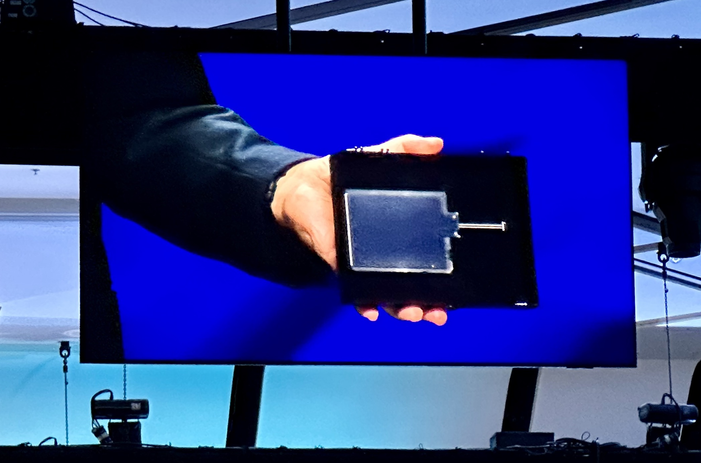
Christian Urricariet is Head of Product Marketing for Silicon Photonics at Intel.
At the Optical Fiber Conference in San Diego on March 26-28, 2024, Intel plans to demonstrate our advanced Optical Compute Interconnect (OCI) chiplet co-packaged with a prototype of a next-generation Intel CPU running live data, giving the industry a look at the future of high-bandwidth compute interconnect.
Additionally, we plan to demonstrate our latest Silicon Photonics Tx and Rx ICs, designed to support emerging 1.6 Tbps pluggable connectivity applications in hyperscale data centers.
Optical I/O as an Enabler to Bringing AI Everywhere
Applications using AI are increasingly being deployed and positioned to be drivers of our global economy and to influence the evolution of our society in general. Recent developments in Large Language Models (LLM) and Generative AI have only accelerated that trend.
Larger and more efficient Machine Learning (ML) models will play a key role in addressing the emerging requirements of AI acceleration workloads. The need to significantly scale future compute fabrics drives exponential growth in I/O bandwidth, and longer reach in connectivity to support larger xPU clusters, as well as architectures with more efficient resource utilization, such as GPU disaggregation and memory pooling.
Electrical I/O (i.e., copper trace connectivity) supports high bandwidth density and low power, but only very short reaches of about 1 meter or less. Pluggable optical transceiver modules used in current data centers and early AI clusters can increase reach but at cost and power levels that are not sustainable with the scaling requirements for AI workloads immediately ahead of us.
A co-packaged xPU (CPU, GPU, IPU) optical I/O solution can support higher bandwidths with high power efficiency, low latency, and longer reach, which is exactly what AI/ML infrastructure scaling requires.
Intel® Silicon Photonics-based Optical I/O Solution
Intel has developed a 4 Tbps bidirectional fully integrated OCI chiplet based on Intel’s in-house Silicon Photonics technology, to address the AI infrastructure’s tremendous need for bandwidth and to enable future scalability. This OCI chiplet or tile contains a single Silicon Photonics Integrated Circuit (PIC) with integrated lasers, an electrical IC (EIC), and a path to incorporate a detachable/re-usable optical connector.
Intel 4 Tbps Optical Compute Interconnect (OCI) Chiplet
The OCI chiplet can be co-packaged with next-generation CPU, GPU, IPU, and other System-On-a-Chip (SOCs) with high bandwidth demand. This first implementation paves the way toward providing multi-Terabit optical connectivity with a >4x improvement in shoreline density over PCIe Gen6, an energy efficiency of <3pJ/bit, <10ns (+TOF) of latency, and a reach greater than 100 meters.
We plan to demonstrate our first-generation OCI chiplet co-packaged with a concept Intel CPU running an error-free link over fiber (BER <10E-12 with a PRBS31 pattern) at OFC 2024 in San Diego on March 26-28 (Intel booth #1501). This first OCI implementation is a 4 Tbps bidirectional chiplet compatible with PCIe Gen5, supporting 64 lanes of 32 Gbps data in each direction over 10’s of meters, realized as eight fiber pairs each carrying eight DWDM wavelengths. Looking beyond this first device, the platform has line of sight to 32 Tbps chiplets.
Concept Intel CPU with co-packaged OCI
OCI Transmitter: Optical spectrum of 8 wavelengths on one standard single-mode fiber
The single PIC in the current die-stack can support up to 8 Tbps bidirectional applications and it contains a complete optical sub-system, enabled by Intel’s unique capability of integrating DWDM laser arrays and optical amplifiers on the PIC, providing orders of magnitude of higher reliability than conventional InP lasers. These integrated Silicon Photonics chips are manufactured at one of our high-volume fabs in the US, which has already shipped more than 8 million PICs with over 32 million on-chip lasers embedded in pluggable optical transceivers for data center networking, with industry-leading reliability. Besides performance advantages and proven reliability, the on-chip laser technology enables true wafer-scale manufacturing, burn-in, and testing, which translates into high subsystem-level simplicity and reliability (e.g., there are no fibers connecting the External Laser Source and PIC), and manufacturing efficiencies.
An additional differentiating advantage is that OCI uses standard, widely deployed single-mode fiber (SMF-28), without requiring Polarization Maintaining Fiber (PMF) like other technical approaches in the market. PMF has been rarely deployed, as system vibration and fiber wiggle can negatively affect its performance and associated link budget.
Several groups inside Intel are contributing to the development and implementation of OCI as a key enabling optical I/O technology. It highlights how Intel can offer a complete next-generation compute solution with our leading silicon, optical, packaging, and platform integration capabilities.
Intel’s field-proven Silicon Photonics technology and platform can provide the highest performance and most reliable optical connectivity solutions to make ubiquitous AI possible.
-------------------------
Post-OFC update:
 Christian Urricariet is Head of Product Marketing at Intel's Silicon Photonics Product Division. Through his career spanning over 20 years in the photonics industry, he has introduced multiple cutting-edge optical connectivity solutions for hyperscale data centers, system OEMs, enterprise, and telecom service providers across the globe, primarily in Product Management roles. Christian holds an Electrical Engineering degree, with a specialization in optoelectronics.
Christian Urricariet is Head of Product Marketing at Intel's Silicon Photonics Product Division. Through his career spanning over 20 years in the photonics industry, he has introduced multiple cutting-edge optical connectivity solutions for hyperscale data centers, system OEMs, enterprise, and telecom service providers across the globe, primarily in Product Management roles. Christian holds an Electrical Engineering degree, with a specialization in optoelectronics.
You must be a registered user to add a comment. If you've already registered, sign in. Otherwise, register and sign in.





